Embroidery with yarn, often called crewel embroidery, is a distinctive and time-honored needlework technique that uses wool yarn to embellish fabric surfaces.
This specialized form of needlecraft traces its origins to the Jacobean era, renowned for its elaborate floral motifs and intricate designs.
Crewel embroidery stands out for its thicker yarn than traditional embroidery floss, imparting a substantial and textured quality to the stitches.
The unique characteristics of crewel embroidery, including the warm feel of natural wool fibers and the incorporation of a diverse range of stitches, contribute to its enduring appeal, making it a timeless and adaptable art form for traditional and contemporary designs.
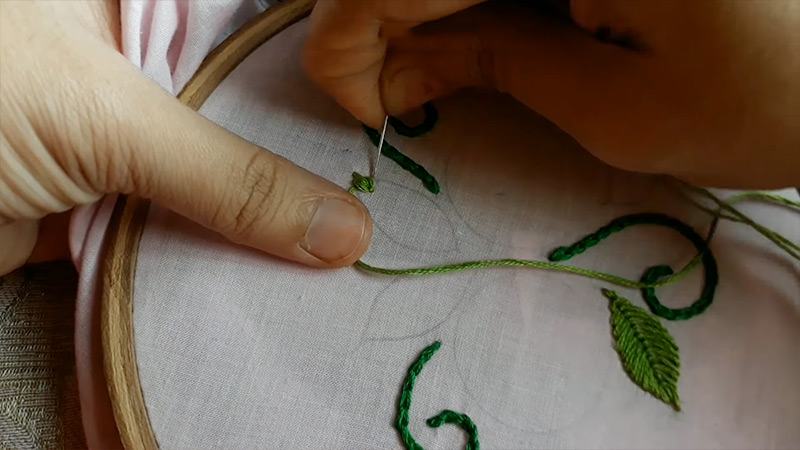
What Is Embroidery With Yarn Called?
Embroidery with yarn, commonly known as crewelwork, is a distinctive style of needlework that employs thick, worsted wool yarn to create intricate designs on fabric.
The term “crewel” originates from the old Welsh word for wool, reflecting the predominant material used in this craft.
One of the charming characteristics of crewelwork is its versatility, allowing for using a wide array of stitches.
In this unique form of embroidery, various stitches such as feather, stem, running, and chain stitches are employed, offering a rich tapestry of textures and patterns.
The thickness and texture of the wool yarn contribute to the tactile and visual appeal of crewelwork, creating a distinct and timeless aesthetic.
This traditional art form has a rich history, often associated with historical and cultural contexts.
Whether adorning clothing, furnishings, or decorative pieces, embroidery with yarn, particularly in the form of crewelwork, adds a touch of warmth, character, and craftsmanship to the finished product.
Characteristics of Crewel Embroidery With Yarn
Crewel embroidery is a form of decorative needlework that uses wool yarn to create intricate and textured designs on fabric.
This type of embroidery has been practiced for centuries and is known for its distinctive characteristics.
Here are the key features of crewel embroidery with yarn:
Wool Yarn
The use of wool yarn in crewel embroidery not only distinguishes it from other embroidery techniques but also plays a crucial role in the aesthetic appeal of the finished piece.
The thickness of the wool yarn contributes to a robust and textured appearance, creating a tactile quality that adds depth to the embroidered surface.
Additionally, the natural fibers of wool offer a cozy and warm feel to the embroidery, making it visually appealing and inviting to the touch.
Jacobean Style
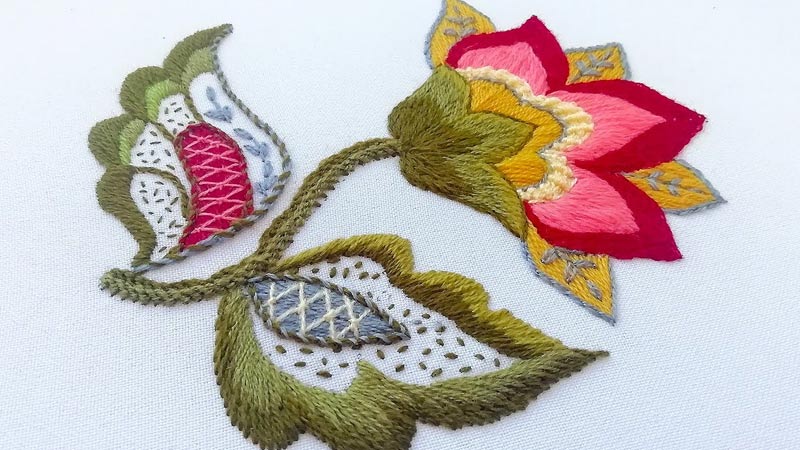
The Jacobean style, prevalent during the late 16th to early 17th centuries, imparts a distinctive character to crewel embroidery.
Elaborate floral and foliage motifs define this style, showcasing a fusion of intricate designs and stylized elements.
The use of various stitches, such as long and short stitches, satin stitches, and chain stitches, is inherent in Jacobean crewel work, creating a harmonious blend of complexity and elegance in the overall composition.
Heavy Fabric
Choosing a heavier fabric like linen or twill for crewel embroidery serves practical and artistic purposes.
The weight and density of the fabric provide structural support for the thicker wool yarn, preventing sagging or distortion over time.
Furthermore, the use of heavy fabric enhances the durability of the embroidery, ensuring that the intricate stitches and vibrant colors withstand the test of time.
Long and Short Stitches
Long and short stitches are integral to crewel embroidery, allowing for the nuanced creation of shading and depth.
These stitches enable a seamless transition between light and dark areas within the design, producing a painterly effect.
The careful interplay of long and short stitches demonstrates the skill and artistry of the embroiderer, contributing to the overall visual richness of the piece.
Raised and Textured Effects
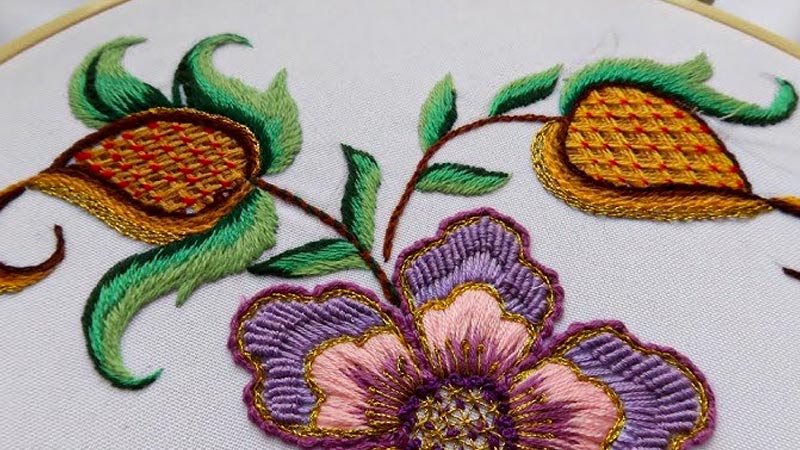
The combination of thicker wool yarn and various stitches contributes to creating raised and textured effects in crewel embroidery.
This three-dimensional quality adds a captivating dimension to the design, making the surface visually exciting and inviting to touch.
The play of light and shadow on the raised surfaces enhances the overall dynamism of the embroidered artwork.
Variety of Stitches
Crewel embroidery showcases diverse stitches, each serving a specific purpose in achieving different effects.
Beyond the fundamental long and short stitches, techniques like chain stitch, satin stitch, crewel stitch, and seed stitch are employed.
This extensive repertoire of stitches allows for intricate detailing, providing ample room for creativity and artistic expression in crafting diverse and captivating designs.
Colorful Palette
A vibrant color palette is a hallmark of crewel embroidery. The wool yarn readily absorbs dyes, offering a broad spectrum of colors that can be seamlessly integrated into a single project.
This characteristic not only enhances the visual appeal of the embroidery but also allows for the creation of intricate color gradients and patterns, showcasing the versatility and adaptability of crewel work.
Traditional and Contemporary Designs
While crewel embroidery has its roots in traditional Jacobean designs, contemporary artists have breathed new life into this art form.
The adaptability of crewel embroidery allows for exploring modern and innovative patterns, breaking away from historical constraints.
This blend of tradition and contemporary creativity ensures that crewel embroidery remains a timeless and evolving craft, appealing to various artistic sensibilities.
Advantages of Cross Stitching With Yarn
Cross stitching with yarn offers several advantages that make it a popular and appealing needlework technique:
Quick Project Completion
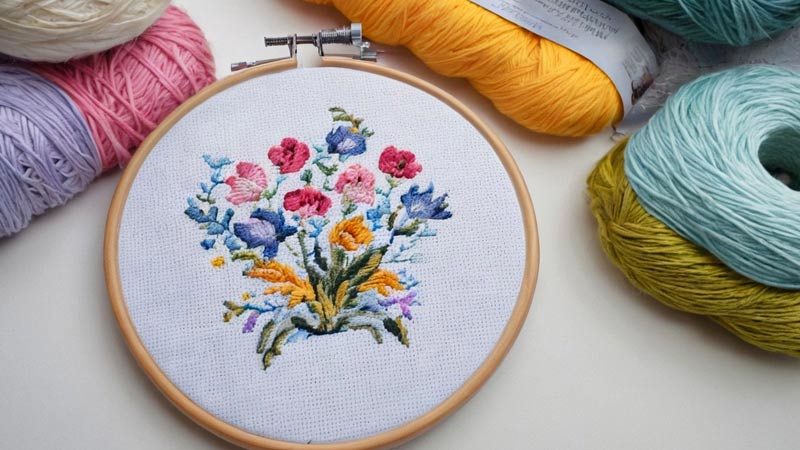
Cross-stitching with yarn significantly accelerates project completion. The larger stitches cover more ground quickly and reduce the time and effort required for intricate patterns.
This efficiency is particularly beneficial for individuals who seek the satisfaction of finishing projects promptly or wish to embark on a quick and rewarding creative endeavor.
Bold and Impactful Designs
The substantial thickness of the yarn elevates the visual impact of cross-stitched designs. The bold and pronounced stitches contribute to a dramatic quality, ensuring the design stands out prominently on the fabric.
Yarn cross stitch becomes an ideal choice for those desiring eye-catching and statement pieces that command attention and admiration.
Cozy and Textured Finish
Using yarn imparts a cozy and textured finish to the cross-stitched fabric. The natural fibers of the yarn introduce warmth and depth, creating a tactile quality that enhances the overall appeal of the finished piece.
This cozy texture adds a touch of comfort and charm, making yarn cross-stitch suitable for various decorative applications.
Versatility in Colors and Textures
Yarn’s extensive array of colors and textures provides cross-stitch enthusiasts with unparalleled creative possibilities.
This versatility allows stitchers to express their styles and preferences, enabling the crafting of unique and personalized projects.
The diverse range of yarn options opens up a spectrum of creative choices for every imaginable design.
Adaptability to Different Fabrics
Cross stitching with yarn showcases adaptability to various fabric types. While well-suited for traditional cross-stitch fabric, the larger stitches also accommodate fabrics with looser weaves.
This adaptability expands the scope of experimentation, inviting stitchers to explore different textures and materials and fostering creativity and innovation.
Modern Twist to Traditional Technique
Yarn cross stitch injects a modern and contemporary twist into the traditional cross-stitching technique.
This innovative approach offers opportunities to reinterpret classic patterns and encourages the exploration of cutting-edge and trendy designs.
It bridges the gap between the timeless charm of cross stitch and the evolving trends in modern crafting.
Suitable for Larger Projects
The efficiency of larger stitches facilitates the application of yarn cross stitches to more extensive and ambitious projects.
Whether creating sizable wall hangings or substantial home decor items, the quicker progress achievable with yarn enhances the feasibility of tackling larger-scale endeavors.
This makes yarn cross stitch an excellent choice for those seeking to make a significant impact with their needlework.
Beginner-Friendly
Yarn cross stitching proves to be a forgiving and accessible entry point for beginners. The larger stitches and the forgiving nature of yarn make it easier for novices to grasp the fundamentals of cross-stitching or embroidery.
This beginner-friendly aspect fosters a positive and confidence-building experience for those new to the world of needlecraft, encouraging them to develop their skills with ease and enjoyment.
What Kind of Embroidery Is Appropriate for Working With Heavy Yarns?
When working with heavy yarns, certain types of embroidery are more suitable due to the thickness and texture of the yarn.
Here are the embroidery techniques that work well with heavy yarns:
Crewel Embroidery
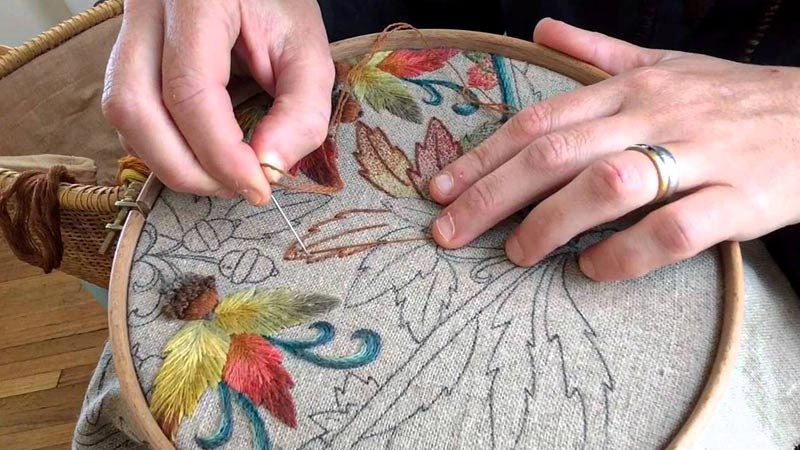
Traditionally done with wool yarn, Crewel embroidery is particularly well-suited for heavy yarns. The thickness of the yarn complements the robust and textured nature of crewel work.
The heavier fabric typically used in crewel embroidery supports the substantial yarn, ensuring the stitches hold well and creating a visually appealing and durable finished product.
Bargello Embroidery
Bargello, also known as flame stitch, is a needlework technique characterized by geometric patterns and long stitches. When using heavy yarns, Bargello embroidery allows for bold and dramatic designs.
The large stitches showcase the yarn’s thickness, creating a visually striking and textured effect on the fabric.
Tapestry Embroidery
Tapestry embroidery involves covering the entire surface of the fabric with stitches, creating a dense and solid design.
This technique is well-suited for heavy yarns, as the thickness of the yarn can quickly fill in the space, resulting in a rich and substantial tapestry. Tapestry embroidery is often used for creating decorative wall hangings or durable fabric items.
Cross Stitch
While traditionally done with embroidery floss, cross stitch can also be adapted for heavy yarns. The larger scale of the stitches and the thicker yarn can give a modern and bold twist to traditional cross-stitch designs.
This approach is particularly practical when working on projects like cushions, where the heavier yarn adds visual and tactile appeal.
Needlepoint
Needlepoint, which involves stitching over canvas with a strong emphasis on covering the entire surface, is compatible with heavy yarns.
The thicker yarn quickly fills the canvas, resulting in a sturdy, textured finished piece. Needlepoint can create items such as pillows, seat cushions, or even wall art with heavy yarns.
Freeform Embroidery
Freeform embroidery, sometimes called contemporary or modern, allows for more experimental and artistic stitching.
This approach is suitable for heavy yarns, as it provides the freedom to create textured and three-dimensional designs.
Artists can explore various stitches and techniques, incorporating heavy yarns to add depth and interest to their creations.
FAQs
What is cross-stitching with yarn?
Cross stitching with yarn is a needlework technique where cross stitches are created using yarn instead of traditional embroidery floss.
How is yarn crossstitch different from regular crossstitch?
Yarn cross stitch involves using yarn as the primary thread for creating cross stitches.
This departure from the finer texture of embroidery floss results in a distinct and often more prominent appearance in the finished piece, offering a modern twist to the traditional cross-stitching technique.
Wrap Up
Embroidery with yarn, commonly known as crewel embroidery, represents a captivating fusion of artistry and tradition.
Rooted in the Jacobean era, this needlework technique showcases intricate floral motifs and elaborate designs crafted with thicker wool yarn.
The tactile warmth of natural fibers and diverse stitches contribute to the timeless charm of crewel embroidery.
Whether adhering to its historical origins or embracing contemporary adaptations, this art form remains a versatile and enduring means of creative expression.
Embroidery with yarn transcends time, inviting enthusiasts to weave a rich tapestry of textures and colors, making it a cherished and adaptable form of artistic storytelling.
Leave a Reply